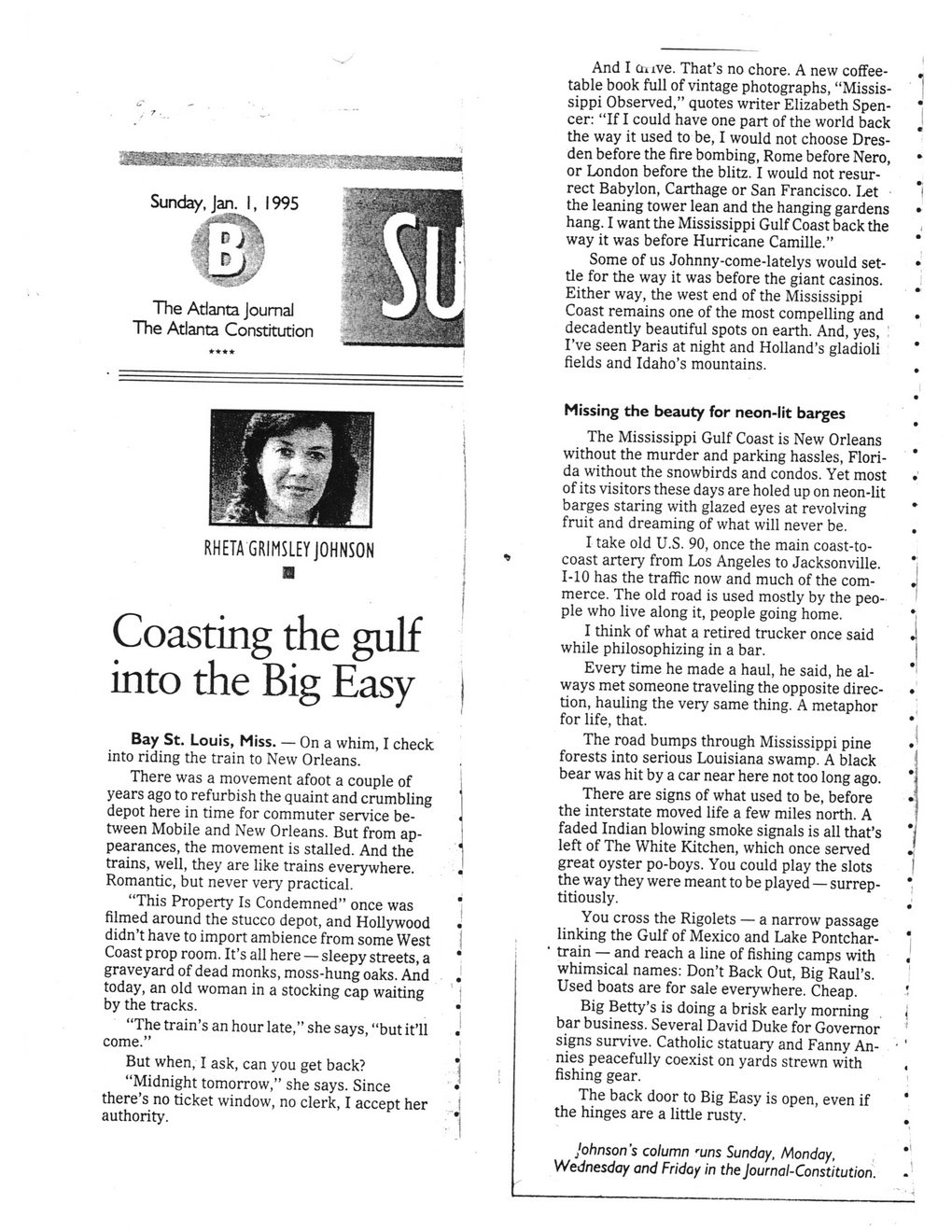This text was obtained via automated optical character recognition.
It has not been edited and may therefore contain several errors.
Sunday, Jan. 1, 1995 The Atlanta Journal The Atlanta Constitution And I aixve. That’s no chore. A new coffee-table book full of vintage photographs, “Mississippi Observed,” quotes writer Elizabeth Spencer: “If I could have one part of the world back the way it used to be, I would not choose Dresden before the fire bombing, Rome before Nero, or London before the blitz. I would not resurrect Babylon, Carthage or San Francisco. Let the leaning tower lean and the hanging gardens hang. I want the Mississippi Gulf Coast back the way it was before Hurricane Camille.” Some of us Johnny-come-latelys would settle for the way it was before the giant casinos. Either way, the west end of the Mississippi Coast remains one of the most compelling and decadently beautiful spots on earth. And, yes, I’ve seen Paris at night and Holland’s gladioli fields and Idaho’s mountains. RHETA GRIMSLEY JOHNSON B Coasting the gulf into the Big Easy Bay St. Louis, Miss. — On a whim, I check into riding the train to New Orleans. There was a movement afoot a couple of years ago to refurbish the quaint and crumbling depot here in time for commuter service between Mobile and New Orleans. But from appearances, the movement is stalled. And the trains, well, they are like trains everywhere. Romantic, but never very practical. “This Property Is Condemned” once was filmed around the stucco depot, and Hollywood didn’t have to import ambience from some West Coast prop room. It’s all here — sleepy streets, a graveyard of dead monks, moss-hung oaks. And today, an old woman in a stocking cap waiting by the tracks. “The train’s an hour late,” she says, “but it’ll come.” But when, I ask, can you get back? “Midnight tomorrow,” she says. Since there’s no ticket window, no clerk, I accept her authority. 1 Missing the beauty for neon-lit barges The Mississippi Gulf Coast is New Orleans without the murder and parking hassles, Florida without the snowbirds and condos. Yet most of its visitors these days are holed up on neon-lit barges staring with glazed eyes at revolving fruit and dreaming of what will never be. I take old U.S. 90, once the main coast-to-coast artery from Los Angeles to Jacksonville. 1-10 has the traffic now and much of the commerce. The old road is used mostly by the people who live along it, people going home. I think of what a retired trucker once said while philosophizing in a bar. Every time he made a haul, he said, he always met someone traveling the opposite direction, hauling the very same thing. A metaphor for life, that. The road bumps through Mississippi pine forests into serious Louisiana swamp. A black bear was hit by a car near here not too long ago. There are signs of what used to be, before the interstate moved life a few miles north. A faded Indian blowing smoke signals is all that’s left of The White Kitchen, which once served great oyster po-boys. You could play the slots the way they were meant to be played — surreptitiously. You cross the Rigolets — a narrow passage linking the Gulf of Mexico and Lake Pontchar-train — and reach a line of fishing camps with whimsical names: Don’t Back Out, Big Raul’s. Used boats are for sale everywhere. Cheap. Big Betty’s is doing a brisk early morning j bar business. Several David Duke for Governor 1 signs survive. Catholic statuary and Fanny An- • ' nies peacefully coexist on yards strewn with fishing gear. The back door to Big Easy is open, even if the hinges are a little rusty. Johnson's column runs Sunday, Monday, Wednesday and Friday in the Journal-Constitution.

BSL 1991 To 1995 一Document (02)